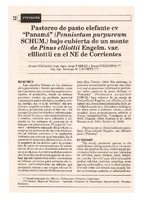| dc.creator | Navajas, Stuart | |
| dc.creator | Fahler, Jorge Carlos | |
| dc.creator | Casanova, Daniel | |
| dc.creator | Lacorte, Santiago María | |
| dc.date.accessioned | 2022-09-25T17:32:05Z | |
| dc.date.available | 2022-09-25T17:32:05Z | |
| dc.date.issued | 1992-07-01 | |
| dc.identifier.citation | Navajas, S., Fahler, J. C., Casanova, D., y Lacorte, S. M. (1992). Pastoreo de pasto elefante cv "Panamá" (Pennisetum purpureum SCHUM.) bajo cubierta de un monte de Pinus elliottii Engelm. var. elliottii en el NE de Corrientes. Yvyraretá: Revista Forestal País de Árboles. Eldorado (Misiones): UNaM. FCF; (3), pp. 72-78. | es_AR |
| dc.identifier.issn | 2469-004X | |
| dc.identifier.other | Yvy-286 | |
| dc.identifier.uri | https://hdl.handle.net/20.500.12219/3706 | |
| dc.description | Fil: Navajas, Stuart. Establecimiento Las Marías (Gobernador Virasoro, Corrientes); Argentina. | es_AR |
| dc.description | Fil: Fahler, Jorge Carlos. Establecimiento Las Marías (Gobernador Virasoro, Corrientes); Argentina. | es_AR |
| dc.description | Fil: Casanova, Daniel. Establecimiento Las Marías (Gobernador Virasoro, Corrientes); Argentina. | es_AR |
| dc.description | Fil: Lacorte, Santiago María. Instituto Nacional de Tecnología Agropecuaria. Centro Regional Misiones; Argentina. | es_AR |
| dc.description.abstract | Las especies leñosas en los sistemas silvo-ganaderos y foresto-ganaderos, como en el presente caso, tienen dos papeles principales: el productivo, donde las leñosas perennes rinden un producto material (raleos para pasta celulósica, madera, resina, forraje, etc.) y el de “servicio”, sin producción tangible (sombra, reciclaje de nutrientes, protección contra el frío, etc.). En su papel productivo árboles y arbustos pueden suplir forraje en sistemas de ramoneo, o madera, material para industria y alimento en los sistemas de pastoreo en el bosque o en plantaciones. El papel de “servicio”, raramente separado del productivo, surge principalmente de las relaciones entre las leñosas perennes y la vegetación herbácea que crece en su proximidad. En el pastoreo en bosques y plantaciones, el efecto negativo de los árboles sobre la producción de pasto es compensado por la contribución de los mismos al sistema a través de otros productos. A nivel mundial se postula que los esfuerzos de investigación en sistemas agrosilvopastoriles deben concretarse en leñosas perennes para sistemas de ramoneo, particularmente en árboles que producen vainas y que tengan efectos favorables sobre el estrato herbáceo que crece bajo ellos (Torres, 1983). Sin embargo, la presente comunicación pretende otro objetivo que es presentar información preliminar sobre el pastoreo de pasto elefante cv “Panamá” (Pennisetum purpureum SCHUM.) bajo cubierta de un monte de Pinus elliottii Engelm. var. elliottii, a fin de lograr una renta complementaria de la actividad forestal en sí. La abundante bibliografía sobre pinus y pasturas existe a nivel mundial, pero principalmente referida a climas templados-fríos. (Lundgren et al, 1983; Pearson, 1984; Pearson et al, 1984; Watson et al, 1984; Byrd et al, 1984). | es_AR |
| dc.description.abstract | The woody perennial species in the cattle forest raising system have two main roles: the productive one, where woody perennials yield a material output (thinning for cellulose paste, timber, resin, fodder, etc.), an the “service” type, with no tangible product (shelter, nutrient recycling, cover against cold weather, etc.). In their productive role trees and shrubs may supply fodder in browsing systems, or industrial material, woods products and food in forest and plantation grazing systems. Service roles, rarely divorced from productive ones, arise mainly from relationships between woody perennials and the herbaceous vegetation growing in their vicinity. In the grazing of native forest an forested areas, the negative effect of the trees and the grass production is compensated by their contribution to the system through other products. From the world wide point of view, it is postulated that research efforts in animal agroforestry should be focus on woody perennials for browsing systems, particularly on pod-bearing trees having beneficial effects on the herbaceous layer growing underneath (Torres, 1983). However, the present research has a different objective that is to provide an advance information on “Panamá” Napier Grass (Pennisetum purpureum) under cover of Pinus elliottii Engelm. Var. elliottii to get an additional income from the forestry activity. There is an abundant bibliography on Pinus and pastures all over the world, but specially that concerning temperate and cold climates (Lundgren et al, 1983; Pearson, 1984; Pearson et al, 1984; Watson et al, 1984; Byrd et al, 1984). | en |
| dc.format | application/pdf | |
| dc.format.extent | 3.671 MB | |
| dc.language.iso | spa | es_AR |
| dc.publisher | Universidad Nacional de Misiones. Facultad de Ciencias Forestales. Instituto Subtropical de Investigaciones Forestales | es_AR |
| dc.relation | info:eu-repo/semantics/altIdentifier/urn/http://www.yvyrareta.com.ar/index.php/ediciones-anteriores/diciembre-2013-n20/item/343-jul-1992-n-3 | |
| dc.rights | Atribución-NoComercial-CompartirIgual 4.0 Internacional | |
| dc.rights | info:eu-repo/semantics/openAccess | |
| dc.rights.uri | http://creativecommons.org/licenses/by-nc-sa/4.0/ | |
| dc.subject | Sistema foresto-ganadero | es_AR |
| dc.subject | Pinus elliottii Engelm. var. Elliottii | es_AR |
| dc.subject | Pasto Panamá | es_AR |
| dc.subject | Silvopastoral systems | es_AR |
| dc.subject | Panamá grass | es_AR |
| dc.title | Pastoreo de pasto elefante cv "Panamá" (Pennisetum purpureum SCHUM.) bajo cubierta de un monte de Pinus elliottii Engelm. var. elliottii en el NE de Corrientes | es_AR |
| dc.type | info:eu-repo/semantics/article | |
| dc.type | info:ar-repo/semantics/artículo | |
| dc.type | info:eu-repo/semantics/publishedVersion | |




